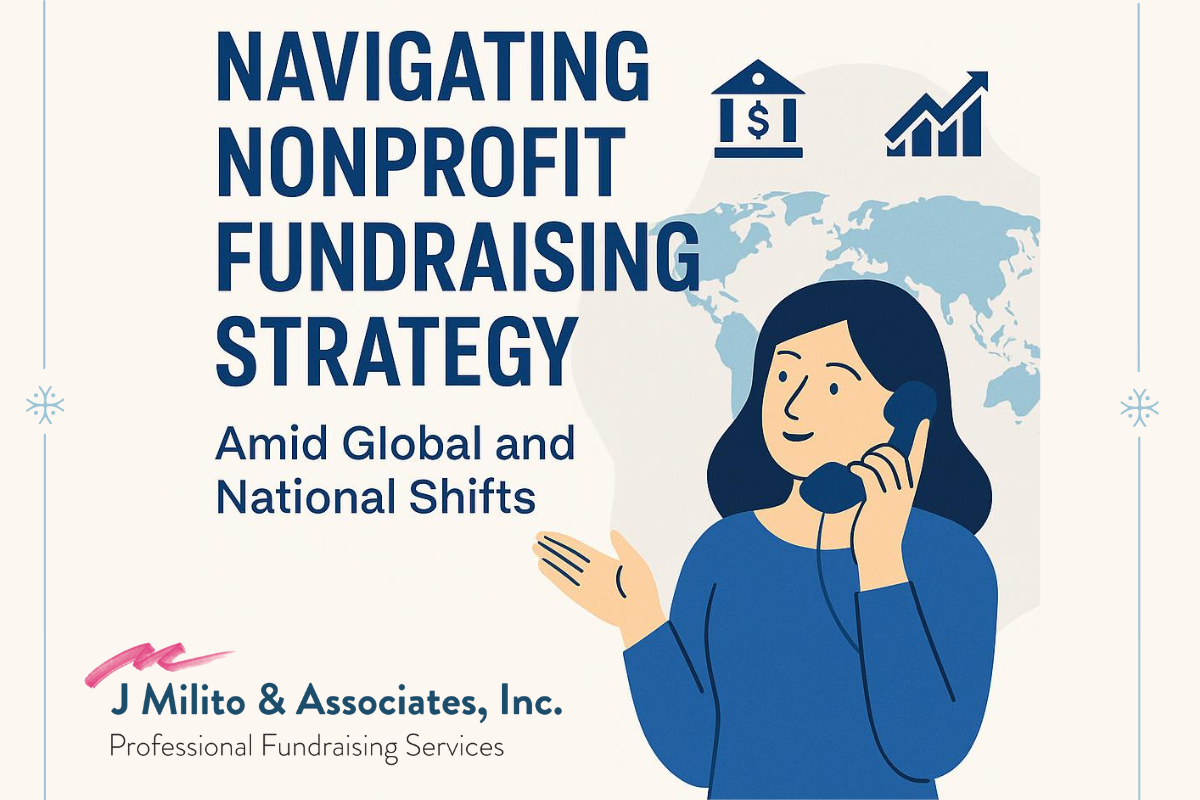In today’s landscape, nonprofit organizations are navigating a complex mix of social, economic, national, and global events that are influencing how they raise money and engage third-party support. These shifts necessitate a more agile, community-driven, and technology-enhanced fundraising strategy.

Global & Economic Trends
- Foreign Aid Reductions: Major cuts to foreign aid by the U.S. and other Western countries have left substantial funding gaps. As public sector resources retract, nonprofits must ramp up private fundraising and grassroots engagement.
- UN Humanitarian Appeal Cutbacks: The United Nations reduced its 2025 aid appeal from $47 billion to $29 billion, highlighting the urgency for NGOs to attract private donors.
- Inflation and Economic Uncertainty: Inflationary pressures and potential recession are constraining household and corporate giving, making donor cultivation and retention more vital than ever.
National and Political Factors
- Policy Shifts in DEI and Human Rights: With reduced funding and support for diversity, equity, inclusion, and human rights initiatives, nonprofits are pivoting towards donor-led and community-anchored campaigns.
- Charitable Tax Incentives: Upcoming changes in tax laws—such as possible expiration of expanded charitable deductions—are shaping donor behaviors and urging nonprofits to act quickly to capitalize on current advantages.
Social and Cultural Influences
- Sponsor Withdrawals and Activism Backlash: Political and legal pressures have led to reduced corporate sponsorship for events like Pride and Juneteenth celebrations. Nonprofits are compensating through enhanced peer-to-peer fundraising.
- Trust and Transparency: Public trust in nonprofits is high, but organizations must maintain that trust through transparency, accountability, and clear impact communication.
Strategic Implications for Nonprofits
- Rapid-Response Campaigns: Flexibility is critical—organizations should be prepared to launch targeted appeals in response to crises or funding cuts.
- Grassroots and Peer-Led Fundraising: Community-driven models and recurring donations are gaining traction as traditional institutional support wanes.
- Technology Integration: Leveraging AI, mobile platforms, and data analytics is essential for donor personalization and effective outreach.
- Major and Planned Gifts: Given economic constraints, focusing on high-impact major gifts and legacy giving offers stability.
- Impact Reporting: Detailed and visual reporting tools build donor confidence and encourage repeat giving.
- Cross-Sector Partnerships: Collaborating with businesses, governments, and other nonprofits can maximize reach and mitigate funding shortfalls.
The Role of Telephone Outreach in Strategic Fundraising
Telephone outreach and fundraising align directly with these strategic implications, offering essential tools for donor engagement and revenue growth:
- Rapid-Response Campaigns: Phone fundraising enables immediate appeals, ideal for emergencies or time-sensitive funding gaps. Live callers can communicate urgency more effectively than digital-only methods, increasing immediate donor response.
- Grassroots and Peer Engagement: J. Milito & Associates’ campaigns strengthen personal donor connections, reactivating lapsed supporters and upgrading giving levels.
- Technology Integration: Calls combined with SMS, CRM, and fulfillment mailings create a seamless multichannel experience. JMA enhances this by pairing phone calls with a thank-you and personalized mail, as offered in the Kick-Start Campaign.
- Major and Planned Gifts: Conversations on the phone can surface prospects for larger or legacy gifts through deeper engagement. Donors often share motivation and capacity more openly in one-on-one conversations than through surveys or email.
- Donor Stewardship and Reporting: Thank-you calls, and personal updates build trust, satisfaction, and loyalty. These stewardship efforts are vital in maintaining trust and encouraging repeat gifts.
- Support for Partnerships and Campaigns: JMA’s full-service outreach—from strategy and calling to mail and donor follow-up—enhances campaign success and ROI.
In short, telephone outreach helps nonprofits turn conversations into commitments—an invaluable asset in today’s evolving landscape.
Conclusion: Nonprofits must remain agile and innovative in the face of evolving global challenges. By embracing community-based strategies, technological advancements, and transparent operations, they can strengthen donor relationships, attract third-party support, and continue to fulfill their mission with resilience and impact.
Sources: - Reuters, AP News, Axios, and sector-specific insights as of June 2025.



